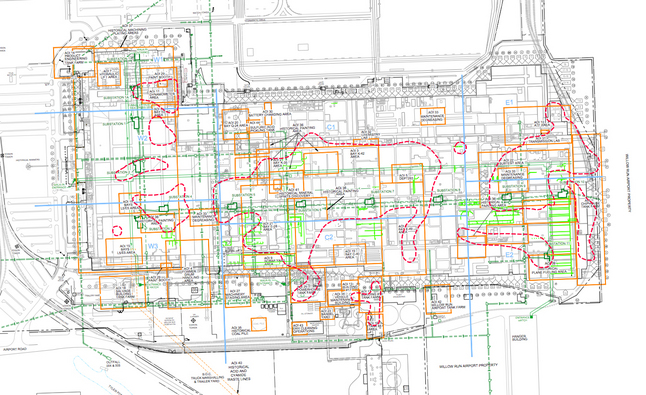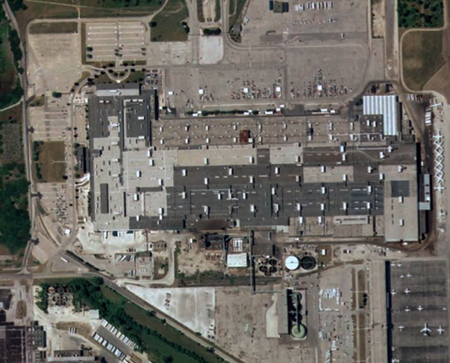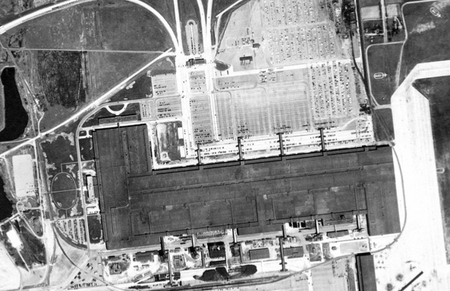
The Willow Run Powertrain Plant in Ypsilanti Township. The areas marked by red dotted lines indicate where about 4.1 million gallons of oil and solvents have contaminated the groundwater below.
Courtesy of MDEQ
Of the 66 properties left vacant after General Motors Corp. filed for bankruptcy in 2009, the site of this plant remains one of the biggest environmental liabilities the company has left behind.
In the settlement agreement that formed the property’s owner — RACER Trust — about $35.8 million of the federal government’s money was allocated to environmental remediation efforts underneath the 83-acre footprint of the facility.
Talks of demolishing the cavernous building have begun to dominate the conversation of redevelopment efforts as RACER Trust entertains interest in the property from numerous parties.

An aerial photo of the GM Powertrain Plant in Ypsilanti Township in 2005.
The pollution
The allocation of $35.8 million for environmental cleanup was based on an evaluation by the Michigan Department of Environmental Quality and the U.S. Environmental Protection Agency on the extent of the pollution at the site.
That allocation makes the site GM’s biggest environmental liability in Michigan, and the second-largest in the country. It’s second only to the Massena Superfund site in New York -- to which the government allocated about $120.9 million for cleanup in the settlement agreement.
Grant Trigger, a professional engineer and environmental attorney, is the cleanup manager for the former GM properties in Michigan.

Grant Trigger
GM first became aware of the pollution problem underneath the Willow Run Powertrain Plant in the early 1980s.
“(The contamination) didn’t happen in a short period of time,” Trigger said, explaining that it’s hard to tell now how long the pollution was seeping into the ground. “The bulk of the manufacturing happened in GM’s tenure in that 60-odd years, how much contamination was released over that period of time?”
Spills of oils and solvents — technically known as Light Non-Aqueous Phase Liquids — were found underground beneath areas of intensive metal processing and underneath sumps, pits, tanks and flumes in the plant.
Underneath the concrete slab on which the plant sits, there are about 40 acres that have been identified as spill sites where oil and solvents have seeped in to the groundwater aquifer that’s about eight to 15 feet underground.
A layer of oil on top of the groundwater aquifer varies from 0.3 feet to three feet thick, according to DEQ reports. Soil underneath the building also is contaminated.
The oil and solvents contain a number of pollutants:
- Volatile organic compounds including cis-1,2-dichloroethene, TCE, vinyl chloride, ethylbenzene, xylenes, methylene chloride
- Semi volatile organic compounds fluoranthene and phenanthrene
- Inorganic compounds of aluminum, arsenic, barium, copper, iron, manganese, mercury, nickel, selenium, vanadium and zinc
- PCBs
Limited investigative and remedial efforts were completed in the 1980s and 1990s, and two remedial investigations were completed in 2001 and 2003.
Since then, there have been no significant environmental cleanup projects, Trigger said.
An investigation contracted in 2010 of the infrastructure underneath the Willow Run Powertrain Plant found leaks from several underground structures, including transformers, tanks, sewer lines, hydraulic lifts and utility corridors like steam tunnels and large-diameter sewers, the DEQ reports stated.
There are about 46 areas of concern on the site.
Stormwater flows
A stormwater drain installed under the entire 83-acre footprint of the building also lies beneath the contaminated groundwater — meaning that the polluted water by nature flows into the collection system.
That stormwater collected underneath the building is treated at a wastewater treatment facility at the Powertrain Plant where the oil and solvents are removed.
HISTORY
Willow Run Powertrain Plant
- The Ford Motor Company built the 2.5 million-square-foot plant on a farm field in 1941 to manufacture B-24 bombers in WWII
- The Kaiser-Frazer Company leases the plant in 1945 and leases the plant in 1948, refurbishing it to make automobiles until it disbanded operations in 1953
- GM purchased the plant in 1953 to manufacture vehicle transmissions
- GM vacated the plant in 2010
The water then flows to the Ypsilanti Community Utilities Authority’s wastewater treatment plant, where it is once-again processed.
Water treated at the Powertrain Plant meets the standards required by the YCUA, according to the DEQ.
The YCUA discharges its treated water near the intersection of Geddes and Beck roads in Canton into the lower Rouge River, which eventually will dumps into the Detroit River and Lake Erie. The YCUA facility meets the requirements of the National Pollutant Discharge Elimination System.
The placement of the stormwater collection system underneath the Powertrain Plant is important in the environmental cleanup process, Trigger said, as it means the contaminated water it collects is treated before it leaves the property.
“In this instance, it’s an advantage for the site,” Trigger said. “While there’s contamination on the site, it’s treated at the plant.”
Kevin Lund, senior geologist with the DEQ working with RACER Trust, said the stormwater recovery system that collects some of the contaminated water and the on-site water treatment facility are key factors in containing the pollution at the site.
"We think there is no immediate threat to human health or to the environment under current conditions," Lund said in an email to AnnArbor.com.
Groundwater in the area generally flows from the northwest to the southeast and is being tracked through monitoring wells, Trigger said.
“We don’t believe there’s groundwater contamination migrating,” Trigger said. “There’s no evidence that it’s moving toward the stream.”
Stormwater runoff from the parking lots and other surfaces surrounding the GM Powertrain Plant flows into Tyler Pond, a man-made pond on the property connected to Willow Run's watershed.
Cleanup plans
The $35.8 million environmental cleanup budget is targeted at the contamination underneath the building.
The goal of RACER Trust’s efforts are to separate the contaminated groundwater from the water that runs off the roof of the plant and into the ground. They're also seeking to develop a longterm strategy to manage the cleanup of the groundwater.
“We’re trying to find a remedy that allows us to treat the contaminated water without mixing the stormwater into it,” Trigger said.

The Willow Run bomber plant in 1945.
Courtesy of the MDEQ
The remaining site evaluations will be conducted this summer, Trigger said.
Within the next six months, Trigger said he expects to have a plan developed to separate stormwater runoff from the building from intermixing with the contaminated groundwater.
Trigger said he expects there to be a long-range plan in place for remediating the contaminated groundwater in the next two to four years. The DEQ would have to approve the plan.
The plan could include the demolition of the plant’s wastewater treatment facility and the construction of a new facility that’s cheaper to operate, Trigger said.
RACER Trust representatives — including Trigger — also will be meeting with Castro at the YCUA next week to discuss wastewater treatment options.
With demolition, new issues arise
The environmental remediation budget for the Willow Run Powertrain Plant was developed under the assumption the building would not be demolished and that the concrete slab on which the building sits would remain in place, according to DEQ reports.
“The concrete pad serves as a cap for the contamination,” Trigger said. “Demolition of the building does not require removal of the concrete pad.”
Recent statements by RACER Trust redevelopment manager Bruce Rasher indicate demolition of the building is now on the table as an option for redevelopment.
"At this time it is uncertain how potential demolition would change exposure and remediation costs," Lund said. "Possible ramifications of building demolition include changes in cost to manage contaminated groundwater/LNAPL and, if the concrete floor would be removed, potential exposure to contaminated soil."
The stormwater management system collecting the contaminated groundwater — on which the environmental remediation relies — could be disrupted with the removal of the concrete slab.
“The slab needs to remain in place,” Trigger said. “If we remove the slab, the environmental remedy is uncertain.”
Demolishing the 72-year-old building would bring with it a number of additional issues — like asbestos removal — RACER Trust’s $35.8 million cleanup budget does not cover.
“The building itself and things above-ground would be a property management issue,” Trigger said, noting those property management costs would be assessed to a developer.
"RACER and DEQ have limited funding to manage the human health and environmental risks at this property," Lund said. "The DEQ no longer has a viable long-term funding source to address legacy contaminated sites like (the Willow Run Power Train) and other contaminated facilities. We were fortunate to receive money from the bankruptcy process for this property.
"If we run out of funding from the bankruptcy process to manage the risks, and without a viable source to address legacy contamination sites, the public and environment may be exposed."
Amy Biolchini covers Washtenaw County, health and environmental issues for AnnArbor.com. Reach her at (734) 623-2552, amybiolchini@annarbor.com or on Twitter.